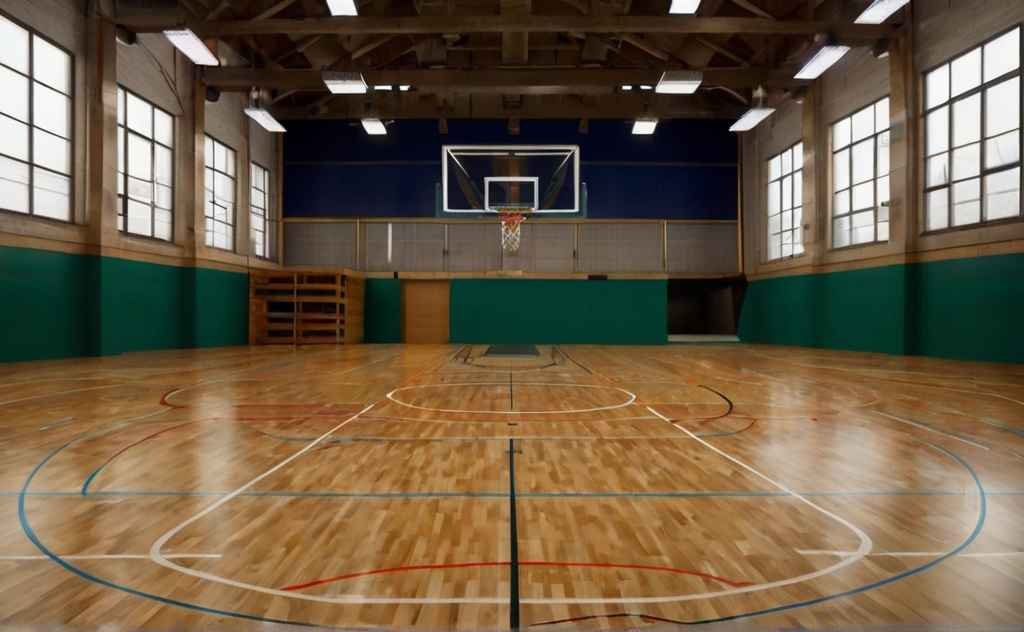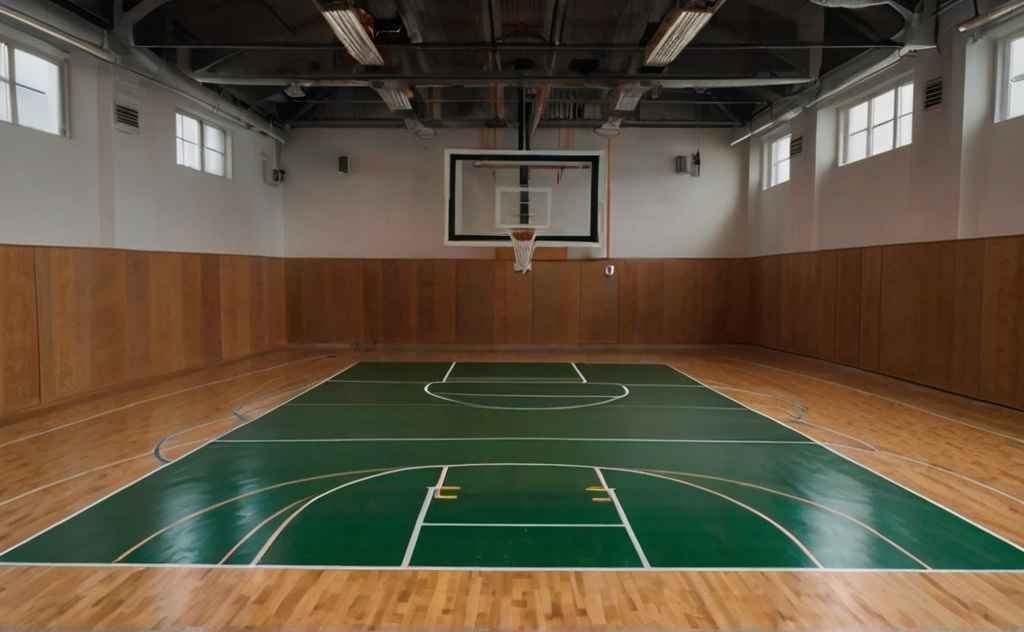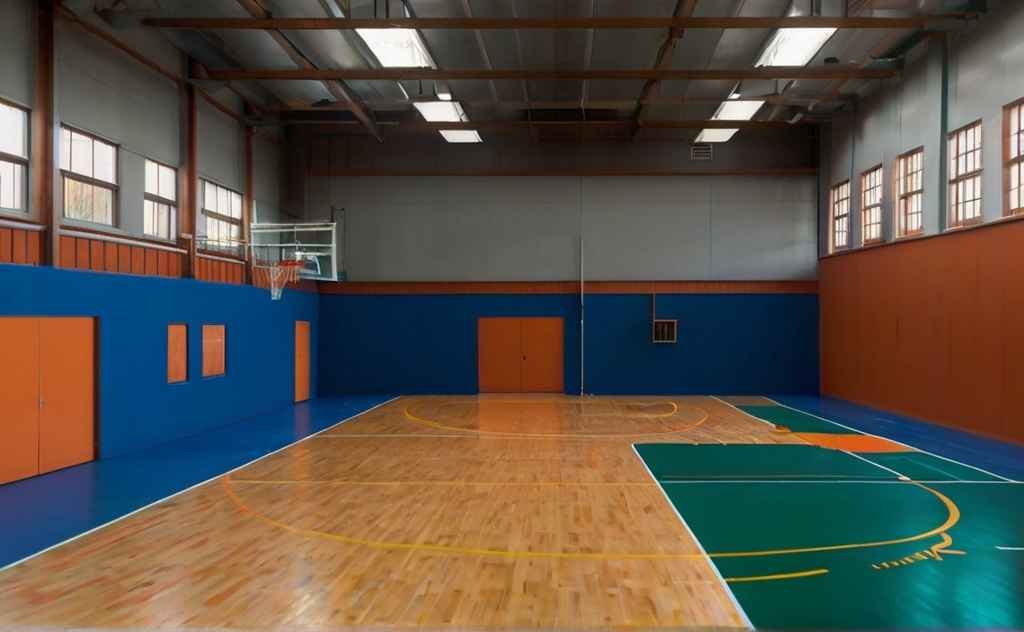Are you ready to get down on the court and become a part of the world of indoor basketball? Think of the electric atmosphere, the sound of sneakers on polished wood, and the excitement in the air as players move down the court. But have you ever stopped to think about what’s really under your feet?indoor basketball courts made of? Courts aren’t just empty rooms; they’re carefully built arenas that are meant to make the game better than ever.
Everything is carefully thought out to make sure the best fun and player safety, from the surface you play on to the materials that make it all possible. So, what are basketball courts inside made of? Take a look at the materials that make hoops glory possible and dive into the fascinating world where skill meets love.
To make sure they work well, are safe and last a long time, these courts need to be carefully planned and built. Choosing the right materials is an important part of making an indoor basketball court. The choice of materials can have a big effect on things like how fun it is to play, how much it costs, and how often it needs to be maintained. This piece will talk about the different materials that are often used for indoor basketball courts, what makes each one good, how to choose the right one, how to install it, how to keep it in good shape, and more.
Materials Used in Indoor Basketball Courts
Indoor basketball courts made of can be constructed using various materials, each offering unique advantages and characteristics. Here are some of the most common materials used:
Wood
Ah, the classic appeal of wooden floors in basketball courts. These floors, which are mostly made of strong woods like maple, are what hold basketball stadiums together all over the world. In addition to looking nice, indoor basketball courts made of wooden floors have the right amount of grip and springiness for players to show off their skills.
They are known for being strong and can handle the constant dribbles, jumps, and quick moves, making sure that the energy of the game doesn’t damage the court. Indoor basketball is played on hardwood, which is more than just a surface. It’s the foundation of every exciting game, and every pass and dunk can be heard echoing off of it.
Synthetic Flooring
Indoor basketball courts made of Synthetic flooring has become a popular option to hardwood for indoor basketball courts. These surfaces, which are made of polyurethane or vinyl, give the standard court experience a modern twist. What makes fake flooring unique is that it can be changed to meet different performance needs while still being durable.
When you want a court that will last and be useful for many years, plastic floors are the best choice. They are easy to clean and can handle the wear and tear of constant play. The technology under the players’ feet changes along with the game, making sure that every dribble, turn, and slam dunk has a solid base.

Rubber Flooring
When it comes to indoor basketball courts made of, rubber flooring stands out because it can soften every move so well. This surface is great for courts where safety and success are very important because it is made to absorb shock. Rubber floors make it less likely for people to slip and fall because they are more stable and have better grip. This lets players push their limits without fear.
These surfaces are known for being very long-lasting, and they can handle the fast pace of the game without losing their structure. When it comes to high-impact sports, rubber flooring is a trusted friend that lets players focus on the game without having to worry about their safety or comfort.
Multi-purpose Flooring
Indoor basketball courts made of Multipurpose flooring is where creativity and adaptability come together to meet the needs of a wide range of sports and activities. This flexible surface, which is made up of rubber, vinyl, and foam, can easily change to the different needs of multi-use facilities. Multipurpose flooring is stylish and useful, and it can be used for a lot of different activities, like basketball, volleyball, or yoga.
Its performance features and style that can be changed make sure that athletes and fans have the best experience possible, no matter what game they are playing. In the world of indoor sports, multi-purpose flooring is the best answer because it combines form and function to make places where everyone can enjoy their hobby.
Explore: What are outdoor basketball courts made of? 5 Best Options
Benefits for indoor basketball courts made of
Each type of material used in indoor basketball courts offers distinct benefits for players and facility owners:
Wood: With its timeless appeal, wooden flooring not only adds a touch of tradition to indoor courts but also boasts remarkable durability. Properly maintained, it can withstand the test of time, offering a reliable surface for decades. Beyond aesthetics, wood excels in shock absorption, lessening the strain on players’ joints during intense games and rigorous practices.
Synthetic Flooring: Embodying versatility, synthetic flooring presents a customizable solution tailored to specific performance demands. Its low maintenance requirements make it an attractive option for facility owners seeking durability without the hassle of extensive upkeep. Even under heavy foot traffic, synthetic surfaces maintain their pristine appearance and functionality, ensuring a consistent playing experience.
Rubber Flooring: Renowned for its ability to absorb shock,indoor basketball courts made of rubber flooring prioritizes player safety above all else. By cushioning impacts from jumps and falls, it creates a secure playing environment suitable for athletes of all ages and skill levels. Its reliability in minimizing injuries enhances the overall enjoyment of the game while instilling confidence in players.

Multi-purpose Flooring: Designed with adaptability in mind, multi-purpose flooring caters to the diverse needs of multi-use facilities. Combining various materials such as rubber, vinyl, and foam, it offers flexibility in both design and performance. From basketball to volleyball to aerobics, this flooring type accommodates a range of activities, empowering facility owners to create custom court layouts that suit their evolving needs.
Considerations for Choosing Indoor Basketball Court Materials
When it comes to outfitting an indoor basketball court, several key considerations should guide your choice of materials:
Durability: The materials you select must be robust enough to endure the rigors of constant use and heavy foot traffic without succumbing to wear and tear. Prioritize options known for their longevity and resilience to maintain optimal performance over time.
Shock Absorption: Ensuring player safety is paramount, and adequate shock absorption is crucial for mitigating injuries and enhancing comfort during gameplay. Opt for flooring materials with sufficient cushioning properties to absorb impact forces, particularly during jumps and landings.
Maintenance Requirements: Factor in the ongoing maintenance needs of each flooring option, including cleaning, refinishing, and repairs. Choose materials that are easy to maintain and cost-effective in the long run to minimize downtime and upkeep expenses.
Cost: Budget considerations play a significant role in material selection. Evaluate both upfront costs and long-term expenses associated with each option to strike a balance between quality and affordability that aligns with your financial constraints.
Installation Process: The installation process can vary depending on the chosen material and the size of the court. From subfloor preparation to surface finishing, each step demands careful attention to detail for optimal results. Consider enlisting professional installation services to ensure precision and durability throughout the process.
Maintenance Tips
To prolong the lifespan of indoor basketball courts made of materials and ensure optimal performance, regular maintenance is essential. Here are some tips for maintaining indoor basketball courts:
- Clean the surface regularly to remove dust, dirt, and debris.
- Use appropriate cleaning solutions and equipment recommended by the flooring manufacturer.
- Inspect the court for any signs of damage or wear and tear, such as cracks or uneven surfaces.
- Repair any damage promptly to prevent further deterioration.
- Schedule periodic inspections and maintenance checks to identify and address issues early on.
Conclusion
Indoor basketball courts made of are essential facilities for athletes to practice and compete in a controlled environment. The choice of materials for these courts plays a significant role in determining their performance, safety, and durability. By considering factors such as durability, shock absorption, maintenance requirements, and cost, facility owners can select the best materials to meet their needs and provide an excellent playing experience for athletes.
FAQs
1.What is the best material for indoor basketball courts?
The best material depends on various factors such as budget, performance requirements, and maintenance preferences. Wood, synthetic flooring, rubber, and multi-purpose flooring are all viable options, each with its own set of benefits.
2.How often should indoor basketball courts be refinished?
The frequency of refinishing depends on the type of material used and the level of use the court receives. Generally, wooden floors may need to be refinished every 5-10 years, while synthetic and rubber floors may require less frequent maintenance.
3.Can synthetic flooring be used for outdoor basketball courts?
Yes, synthetic flooring can be used for outdoor basketball courts. However, it’s essential to choose materials specifically designed for outdoor use to ensure durability and weather resistance.
4.Are indoor basketball courts suitable for other sports?
Yes, indoor basketball courts can often be adapted for other sports and activities, such as volleyball, badminton, or fitness classes. Multi-purpose flooring allows for flexibility in usage, making it suitable for a wide range of activities.
5.What is the average lifespan of indoor basketball court materials?
The lifespan of indoor basketball court materials varies depending on factors such as material quality, maintenance practices, and level of use. Generally, well-maintained wooden floors can last 20 years or more, while synthetic and rubber flooring typically have lifespans of 10-15 years.






2 Comments
[…] Explore: What are indoor basketball courts made of? […]
[…] Explore: What are indoor basketball courts made of? […]